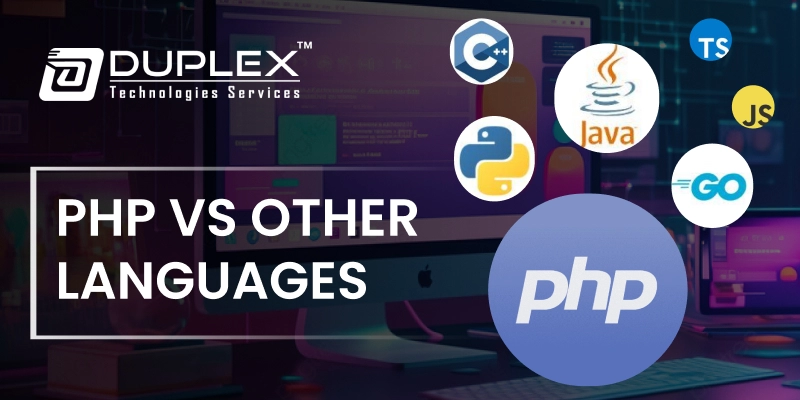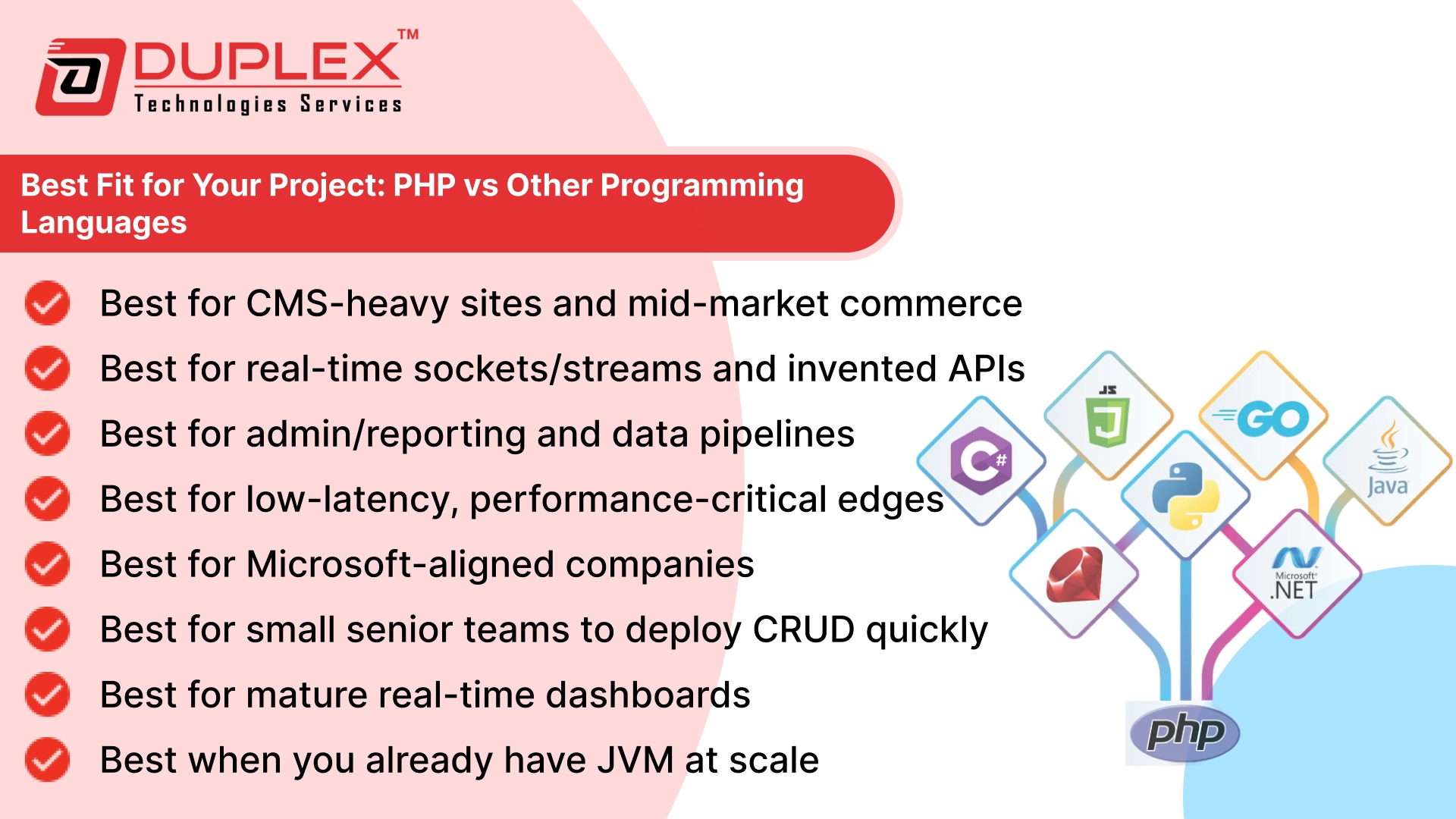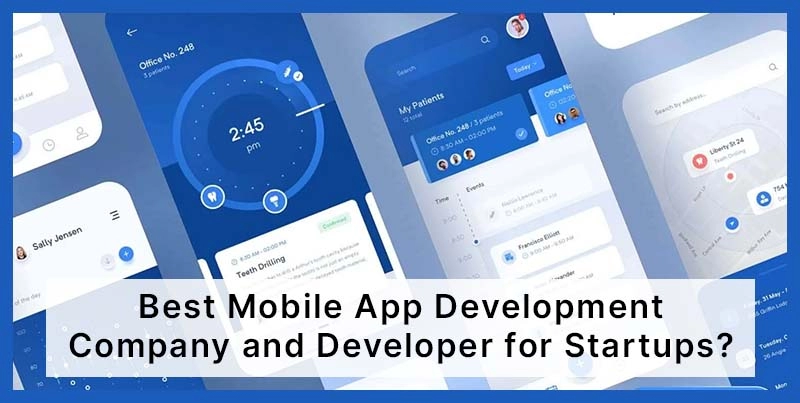PHP vs. Other Languages: Make the Right Call for Your Next Build

Posted By : Anand, Posted Date : Aug 18, 2025
PHP vs Other Languages: Why PHP Wins for CMS and Mid-Market E-Commerce
As a web development agency and software development company, we see PHP outcompete php alternatives for general web tasks.
Faster to deploy for CMS and mid-market e-commerce; editors push content without custom builds.
- Simple ops: Nginx + PHP-FPM, opcache, easy horizontal scale, quick rollbacks.
- Better caching: page/fragment + Redis or Memcached + CDN = big payoffs with moderate compute.
- Laravel advantages: Horizon queues, jobs, broadcasting, Pest/PHPUnit, and Laravel Octane for higher throughput.
- Lower TCO in typical scenarios; stay in LTS and have dependencies kept tidily trimmed.
- Easier recruitment and takeover; conventions speed onboarding.
- Writes well in heterogeneous stacks: use PHP for CMS/checkout; supplement with Node.js for sockets, Python for data, and Go for gateways.
- Bottom line: For content sites and mid-market shops, PHP gives speed, stability, and rock-solid operation. Use targeted services in other languages when you need real-time or maximal performance.
Table of Contents
- PHP vs Other Programming Languages: A Practical 2025 Guide for Real Projects
- PHP Alternatives: Workload-Based Picks to Compare PHP and Other Languages
- Best Fit for Your Project: PHP vs Other Programming Languages
- PHP vs Other Languages: Choose the Stack That Fits Your Roadmap
- PHP vs other languages: compare PHP and other languages for a website development company
- Website development company and php vs other languages: scope, velocity, and risk
- Compare php and other languages for API, CMS, and e-commerce realities
- Software development company on php alternatives: security and scalability truths
- PHP vs other languages for TCO: build, run, and evolve costs
- Compare php and other languages in DevOps & integration pipelines
- PHP alternatives and hiring: talent pools, learning curves, and time-to-market
- Website development company guidance on php vs other languages: maintenance & LT support
- Why Choose Duplex Technologies?
PHP vs Other Programming Languages: A Practical 2025 Guide for Real Projects
PHP is a server-side scripting language built for the web. With Laravel and Symfony frameworks, it is utilized for CMS-powered sites (WordPress, Drupal, Craft), mid-level e-commerce (WooCommerce, OpenMage, Bagisto), and content platforms. Typical stack: Nginx → PHP-FPM with opcache, supplemented with object caching using Redis or Memcached. It excels where page rendering, caching, and editorial processes are the primary activities.
Common PHP applications:
- Marketing sites, portals, knowledge bases, membership sites
- Storefronts with promotions, catalogs, and checkout
- API layers for e-commerce/CMS front ends
- Monoliths that nevertheless need queues, jobs, and scheduled tasks (Laravel Horizon)
PHP Alternatives: Workload-Based Picks to Compare PHP and Other Languages
|
Stack |
Use when |
Strengths |
Trade-offs |
|
Node.js/TypeScript (Express, NestJS) |
Real-time APIs, websockets, streams, microservices |
Non-blocking I/O; one language end-to-end; huge npm ecosystem |
Dependency sprawl; needs workers for CPU-bound tasks; version churn without lockfiles |
|
Python (Django, FastAPI) |
Python (Django, FastAPI) |
Django admin; rich data/ETL tooling; FastAPI for typed JSON |
GIL limits CPU threads; lower raw throughput than Go/Rust; packaging pitfalls for newcomers |
|
Ruby on Rails |
Fast CRUD, product MVPs, small senior teams |
Convention-over-configuration, rapid Hotwire/Turbo, Sidekiq |
Smaller hiring pool; tuning at scale; gem curation to avoid drift |
|
NET (C#) |
Microsoft estates, Azure, Entra ID/AD integration |
Kestrel performance, first-class identity, powerful tooling |
Heavier runtime than Go; enterprise conventions may slow change |
|
Go (Gin, Fiber, Echo) |
High-throughput APIs, gateways, CLIs, small services |
Tiny static binaries; fast startup; goroutines for simple concurrency |
Minimalist stdlib; some ORMs verbose; generics broadly usable but patterns evolving |
|
Java (Spring Boot, Quarkus, Micronaut) |
Large systems, strict SLAs, JVM shops |
Vast ecosystem; strong profiling/observability; Quarkus/Micronaut + GraalVM for faster startup/native images |
More verbose; memory/build times can climb without tuning |
|
Elixir (Phoenix) |
Chat, notifications, real-time dashboards, fault tolerance |
BEAM lightweight processes; supervision trees; Channels/LiveView |
Niche hiring; actor-model learning curve; fewer enterprise libs |
|
Rust (Actix Web, Axum) |
Low-latency services, edge gateways, performance-critical paths |
Memory safety without a garbage collector; predictable latency |
Steep learning curve, long compile times, smaller web ecosystem |
|
Kotlin (Ktor, Spring) |
Modern JVM services with concise syntax |
Coroutines, null-safety, seamless Java interop |
JVM footprint remains; fewer Kotlin-native libs; smaller talent pool |
|
Scala (Play, Akka HTTP) |
Streaming pipelines, typed FP, high concurrency |
Powerful type system, Akka Streams/actors, and JVM tooling |
Language complexity, heavier builds, harder hiring |
|
Deno (Oak, Fresh) |
Secure TypeScript services, edge runtimes |
Permissioned runtime; built-in test/format/lint; URL-based modules |
Smaller ecosystem than Node.js; API differences; migration effort |
Tip: For CMS or mid-market e-commerce, PHP (Laravel/Symfony) still offers the fastest path to value. For sockets/streams, pair PHP with a small Node.js service.
Best Fit for Your Project: PHP vs Other Programming Languages

There isn’t a single winner; “best” maps to what you’re building and how you’ll operate it.
- Best for CMS-heavy sites and mid-market commerce: PHP with Laravel/Symfony + WordPress/Drupal/Craft (fast authoring, predictable caching, wide hosting options).
- Best for real-time sockets/streams and invented APIs: Node.js/TypeScript (non-blocking I/O, one language across client and server).
- Best for admin/reporting and data pipelines: Python/Django/FastAPI (Django admin, rich data tooling, clean typed APIs).
- Best for low-latency, performance-critical edges: Go or Rust (small artifacts, predictable latency).
- Best for Microsoft-aligned companies: NET (C#) (Kestrel performance, tenant/identity support, Azure alignment).
- Best for small senior teams to deploy CRUD quickly: Rails (speed, conventions).
- Best for mature real-time dashboards: Elixir (Phoenix LiveView/Channels, supervision trees).
- Best when you already have JVM at scale: Java/Kotlin/Scala (gigantic ecosystem; Quarkus/Micronaut and GraalVM improve startup and footprint).
If your roadmap has content, catalogs, and editors at its center—and you require quick time-to-value with uncomplicated hosting—PHP generally is the best end-to-end solution. If real-time interaction or heavy event processing is your fundamental need, use Node.js for those services and store content on PHP.
PHP vs Other Languages: Choose the Stack That Fits Your Roadmap
Technology choices should map to constraints, not trends. At Duplex Technologies, we act as both a website development company and a software development company, guiding builds and migrations across PHP, Node.js, Python, Ruby, and .NET. Our approach is simple: ship value quickly, keep operations boring, and leave a codebase your team can sustain for years.
PHP vs other languages: compare PHP and other languages for a website development company
Decisions around php vs other languages and comparing php and other languages hinge on what you’re building and how you’ll operate it. PHP (especially Laravel or Symfony) excels for CMS-driven sites and mid-market commerce: predictable caching, straightforward PHP-FPM deployments, and battle-tested LAMP patterns that keep surprises low during go-live.
Compare that to event-heavy back ends, websockets, or lots of small concurrent requests. These days, Node.js (Express or NestJS) is a better choice because its non-blocking I/O makes long-lived connections and message-driven architecture simpler. Python (Django, Flask, FastAPI) shines when data workflow, admin back offices, or ML-adjacent features are in the roadmap. Ruby on Rails still offers speedy CRUD with decent conventions. NET is a perfect fit for Windows estates, Azure services, and typed tooling. The right call maps the workload onto the run reality that you are able to maintain.
Best PHP Alternatives
Node.js (Express, NestJS)
Use when: sockets, streaming, evented APIs, microservices.
Pros: TypeScript on both ends. Non-blocking I/O, a ginormous npm registry, and terrific WebSocket patterns.
Cons: Async anti-patterns; package churn without lockfiles; CPU-bound work requires workers or another service.
Python (Django, FastAPI, Flask)
Use when: admin back offices, data workflows, reporting, ML-adjacent features.
Pros: Django admin for instant CRUD; FastAPI for typed JSON APIs; better ETL/scripting tools.
Trade-offs: Less raw throughput than Go/Rust; CPU thread bound by GIL; packaging may surprise the newbs.
Ruby on Rails
Use when: product CRUDs, dashboards, and dev throughput.
Pros: Convention over configuration; quick scaffolding; Sidekiq/ActiveJob for backgrounding; Hotwire for responsiveness.
Trade-offs: Smaller talent pool to poach from; high-scale tuning; too-long-running jobs must run off the web tier.
ASP.NET Core (System .NET, C#)
Use when: Microsoft stack, Azure, Windows integration.
Pros: Kestrel perf; first-party identity (AD/Entra ID); good IDE/tooling.
Trade-offs: heavier runtime than Go; orgs usually expect MS tooling; licensing/ops conventions differ per enterprise.
Go (Gin, Fiber, Echo)
Use when: high-throughput APIs, gateways, CLIs, extremely small services.
Pros: Goroutines for low-ergonomic, lightweight concurrency; extremely small static binaries; low start time and memory.
Trade-offs: Pretty much no ergonomics; generics are still immature in practice; ORMs are clunky.
Java (Spring Boot, Quarkus, Micronaut
Use when: large systems, fresh SLAs, JVM ops teams.
Benefits: Experimental libraries and profiles; better performance; Quarkus/Micronaut cold starts can be adjusted.
Drawbacks: Everywhere except lighter cost stacks; more memory usage; longer compile times except heavy support.
Elixir (Phoenix)
Use when: chat, notifications, real-time dashboards, fault-tolerant services.
Benefits: Native Supervision and concurrency on BEAM; de-sugarized front-end code through Phoenix LiveView; low-latency processes.
Drawbacks: Expert talent hires; actor-model learning curve; fewer enterprise off-the-shelf libraries.
Rust (Actix Web, Axum, Rocket)
Use when: low-latency APIs, edge gateways, performance-critical work.
Pros: Safe memory no GC; predictability of performance; systems glue heaven.
Cons: Slick learning curve; long compilation times; lesser web library foundation.
Kotlin (Ktor, Spring)
Use when: new JVM services with less boilerplate.
Pros: Null safety; coroutines for structured async; use Java libraries.
Advantages: JVM overhead reduced; more Kotlin-native libraries than Java; larger pool of hires.
Scala (Play, Akka HTTP)
Use when: there is high concurrency, typed FP, or streaming pipelines.
Strengths: Akka Streams/actors; good type system; takes advantage of JVM tooling.
Weaknesses: difficult to hire; compilation performance; language complexity.
Deno (Oak, Fresh)
Use when: edge runtimes, TypeScript services with lowered permissions.
Strengths: Module resolution by URLs; permission sandbox; test/format/lint built-ins.
Weaknesses: API inconsistencies; cost of porting from Node projects; less complete set of packages than Node.js.
Website development company and php vs other languages: scope, velocity, and risk

A web development company like Duplex Technologies must weigh php against others as a delivery risk and not an appetite. When merchandisers and editors take the lead direction, PHP frameworks and modern CMS solutions (WordPress, Drupal, and Craft) drive time-to-value. You obtain mature writing, stable plugins, and caching playbooks by design with Nginx, PHP-FPM, and edge CDNs.
In contrast, platform back ends with heavy event handling or real-time features benefit from Node.js services with message queues and workers (BullMQ), while Python supports ETL, reporting, and analytics pipelines without context switching to a different language layer. Rails achieves quick CRUD with a coherent mental model. Your choice should reflect incident response and SLAs: who patches dependencies, who handles rollbacks at 2 a.m., and how you’ll observably confirm fixes with traces and metrics.
Quick Summary
- Apply PHP/Laravel to CMS and commerce where caching and editorial workflows prevail.
- Prefer Node.js for websockets, event streams, and high concurrency APIs.
- Take Python where analytics, ETL, or governance-heavy admin tools are critical.
Compare php and other languages for API, CMS, and e-commerce realities
Groups that compare php and other languages well begin with API shape and content workflows, then layer php alternatives for specialized requirements. Headless content with Node-based CMSs (Strapi, Directus) scales multi-channel publishing and webhook automation. Laravel + Filament or Nova creates robust admin consoles without over-engineering.
E-commerce covers monoliths and headless. PHP platforms—WooCommerce, OpenMage (Magento community fork), and Bagisto—provide catalogs, promotions, and payments with rich plugin ecosystems. For higher velocity carts and advanced storefronts, headless implementations on top of Node services with a frontend framework or a commerce SaaS (e.g., commercetools) allow for the separate scaling of cart, inventory, and pricing. Python is paired with these builds for fraud scoring, reconciliation tasks, or data-quality validation. Rails alternatives like Solidus still stand their ground when an opinionated back office is an advantage.
Software development company on php alternatives: security and scalability truths
A high-powered php alternative organization starts with the supply chain. In PHP, static analysis (PHPStan/Psalm) supplemented by Composer and frequent dependency scanning reduces transitive risk to a minimum. Prepared statements, route-model binding, and CSRF protection are table stakes; environment variables—not config files—ought to be where secrets go. Laravel Octane and conservative opcache tweaking achieve more throughput from slammed instances.
Node.js requires strict control of lockfiles and npm sprawl to promote predictable attack surface; low dependencies and small images minimize patch cycles. Virtualenvs and hash-pinned requirements for Python constrain drift. On stacks, place a WAF in front of public-facing endpoints, demand TLS with HSTS, and stream OpenTelemetry for hot paths' monitoring in prod. Horizontal replicas, object Redis or Memcached caching, and job queues minimize tail latency without rewriting core logic.
PHP vs other languages for TCO: build, run, and evolve costs
Placing php on par with other languages on TCO with the co-founder of a web development business, several build, run, and evolve cycles. Build time is convention-dependent: Laravel scaffolding and Blade/Livewire slash boilerplate for dashboards, auth, and forms. Node can also keep up when teams already write in TypeScript and duplicate models from client to server.
Run costs are issues of hosting, observability, and support windows. PHP remains inexpensive to host in containers or managed LAMP; it adores edge caching and easy blue-green deployment. Node-based service adores serverless or containers for spikes in workload, though it increases complexity with orchestration if you're partitioning too aggressively. Evolve costs depend on your debt profile: plugins speed launch but add ongoing update effort; custom code is more costly up front but pays back if you'll be extending the domain model frequently.
Quick Summary
-
Build time is traditional—Laravel and Django bypass boilerplate; Node excels with TypeScript shops.
- Run cost favors vanilla PHP stacks; serverless will likely favor Node for bursty workloads.
- Evolution costs reflect plugin debt versus clean, well-scoped custom code.
Compare php and other languages in DevOps & integration pipelines
With other languages when compared to php, reliability is what is made by small things. In a workflow for a software development company, PHP can be integrated well with Nginx + PHP-FPM containers; Composer caches keep CI fast. Pest/PHPUnit, PHP-CS-Fixer, and static analysis integrate well with GitHub Actions or GitLab CI, and rollout strategies like blue-green or canary are simple to implement on container platforms.
Node favors monorepos with workspaces (pnpm), which are easy for microservices and shared libraries. Python relies on wheels and pinned dependencies for reproducibility. Integration-wise, PHP offers decades of CRMs, marketing tools, and payment gateway SDKs; Node usually gets the most recent SDKs first. Stack-wise, wire logs, metrics, and traces into APMs like New Relic or Datadog so you can see regressions right away and roll back without hesitation.
PHP alternatives and hiring: talent pools, learning curves, and time-to-market
Engagement timelines drive as much as construction. php alternatives versus a website development company engagement pit PHP against a deep worldwide mid-tier talent base and quick onboarding across Laravel standards. That predictability spurs faster code reviews and stabilizes delivery rhythms.
Node is able to support front-end and back-end thinking when teams are already coding in TypeScript; fewer context switches = faster iteration and simpler cross-training. Python brings cross-discipline ability—data engineering, scripting, web—useful when analytics competency is in scope. Rails experience is dense and potent but less in total number; .NET experience combines with enterprises. The optimal hiring strategy starts with conventions and mentoring: code-alongs, light style guides, and small enough pull requests to review in a flash.
Quick Summary
-
PHP/Laravel: high mid-level availability and rapid onboarding.
- Node/TypeScript: one language for both client and server.
- Python/Django: high redundancy with data roles.
Website development company guidance on php vs other languages: maintenance & LT support
An experienced web development company puts php vs other languages into a calendar problem: releases, deprecations, and OS rotations will happen; your workflow is what makes them painful. Website development company guidance on php has consistent releases and extended support periods; use supported minors and schedule quarterly dependency updates. Laravel's upgrade documents are sane—treat them as regular business, not emergencies.
Node demands runtime version care and rebuilds of native modules with base image updates. Django's LTS cycle keeps updates in check when third-party libraries are light. Updates to Rails are seamless with excellent testability and convention over configuration. For all stacks, maintain a budget of dependencies, scan weekly, and watch a patch-to-prod SLO. Instrument everything on day one; observability turns "it's slow" into traces you can fix in one deployment.
Why Choose Duplex Technologies?
- We hear you out first, then write what really shifts the needle.
- One partner for the whole stack: we're a web development company and software development company.
- We select the tools that suit your job best—PHP/Laravel, Node.js, Python/Django, or .NET—no bias.
- Lightning-fast pages and improved search visibility, with Core Web Vitals and SEO built in.
- Safe deploys: automated testing, quick rollbacks, and plain-English monitoring you can rely on.
- Lower running expenses with lean hosting and smart edge caching.
- Knowledge of WordPress and Drupal—or headless deployments; stores on WooCommerce, OpenMage, Bagisto, or commercetools.
- Security on by default: encrypted traffic, hardened endpoints, and secure secrets management.
- Clear roadmaps, true SLAs, and open pricing—no surprises.
- Clean, readable code your team can understand and own.







































